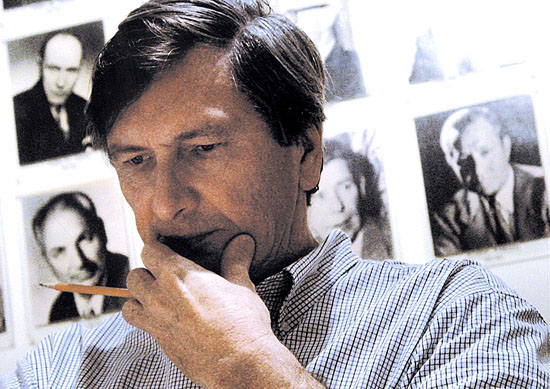Students fill the spaces between stage walls, dated sofas and a fake fireplace of the set built on Sound Stage 3 of Melnitz Hall. Famed cinematographer John Bailey, this year’s visiting Kodak Cinematographer-in-Residence, waits in the dining-room-turned-lecture-hall, ready to share his unique perspective with UCLA film students.
“It’s like being in Picasso’s studio ““ having the drips of paint on the floor and then you sit down with Picasso, and he’s like, “˜Let’s talk about the art that we do and what inspires me,'” said cinematography Professor William McDonald, who founded the Kodak Cinematographer-in-Residence program.
John Bailey (“The Big Chill,” “Groundhog Day”) of the American Society of Cinematographers is the 11th cinematographer to come from the film industry trenches to serve as UCLA’s Kodak Cinematographer-in-Residence. Like past holders of this position, he will conduct weekly workshops and screenings with a perspective oriented toward the artistry behind cinematography.
“I thought it would just be ideal moving into our second decade of this program to have someone really talk with the students and really get them to see and understand the role of the cinematographer as a visual storyteller,” McDonald said. “I’ve always been aware of John’s interest in the idea of cinematography’s visual storytelling being a fusion of many different art forms. Sculpture, painting, literature, etc.”
From films such as “American Gigolo” and “The Big Chill” to “The Sisterhood of the Traveling Pants” and “How to Lose a Guy in 10 Days,” McDonald said that Bailey’s varied filmography sets him apart as a cinematographer and also makes him an inspiration to UCLA film students who admire artistry as well as success as future filmmakers.
“In his films he focuses on not just flashy visuals, but visuals that help the story,” said Phil Klucsarits, a graduate student in cinematography. “It’s refreshing to hear that from someone because it’s a confirmation of things we’ve been doing here.”
Klucsarits’ choice to come to UCLA, despite being an engineering student as an undergraduate, was influenced by UCLA’s Cinematographer-in-Residence program. After four years in the program, Klucsarits has already worked with several resident cinematographers, and he finds Bailey interesting because of both his commercial and artistic success.
“Many of his films are ones where film students have seen them and commercially are seen as well,” Klucsarits said. “That was inspiring when I was deciding to go to film school.”
Bailey himself wasn’t always set on a career as a cinematographer. He began with an interest in film aesthetics and the appreciation for the wider range of art forms attributed to him by McDonald. While hoping to pursue a career in criticism of film aesthetics, Bailey was admitted to USC’s first class of graduate cinematographers in the mid ’60s.
“I learned about the concept of caméra-stylo ““ the camera as a writing instrument, as the pen of cinema,” Bailey said. “I became so intoxicated with the image and creation of the image that I decided to spend my life doing it.”
Bailey learned under the likes of Vilmos Zsigmond, last year’s Kodak Cinematographer-in-Residence, before pursuing a wide and varied film career of his own. Over the years, he has done numerous workshops and residencies with Kodak and even shares his film insight through a blog on the American Society of Cinematographers’ website. His experience as a cinematographer-turned-teacher has taken him across the country and throughout the world.
Bailey said foreign films have always had a strong influence on him as an artist, and his work abroad has given him some of his greatest experiences as a cinematographer. From film topics that are off the radar for most American filmmakers to equipment so much less advanced than what he’s used to, traveling abroad has provided him with the most interesting challenges.
“I find that I have to adapt myself to the resources available,” Bailey said. “I love the challenge … to see what’s different and the connective tissue.”
His residency began last week, but it will kick off with a public screening of his past work “Mishima: A Life in Four Chapters” tonight at 8 in the James Bridges Theater. Selected by Bailey himself, it’s a film he’s especially proud of artistically, and the screening will give him the opportunity to talk about it with the UCLA community.
“That’s really what the residency is about ““ to allow cinematographers to have a soapbox for a moment that they often don’t get,” McDonald said. “John doesn’t usually get to come to a major film school and be in residence for a number of sessions and really just uncork the bottle and let his genie out.”
